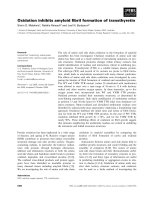Formation of sedimentary rock powerpoint
Bạn đang xem bản rút gọn của tài liệu. Xem và tải ngay bản đầy đủ của tài liệu tại đây (3.07 MB, 15 trang )
SEDIMENTARY ROCKS
There are 2 ways sedimentary rocks are formed
1.
Clastic are made from sediments glued
together
2.
Non-clastic: not glued together---include
chemical & biochemical/organic
EDIMENTARY ROCKS WILL CONTAIN FOSSILS
SEDIMENTARY ROCKS FORM IN LAYERS
CALLED STRATA
Oldest rocks are on the
bottom….youngest on top
This is a good example of Stratification
THE 2 CLASSES OF SEDIMENTARY
ROCKS
1. CLASTIC Sedimentary Rocks are made from sediments
that come from pre-existing rocks that have been weathered
(breaking down into smaller pieces) and eroded (transported
away) then glued together.
The 2 types of weathering include physical (only size changes)
and chemical (a new substance is formed).
Sediments range in size from tiny pieces of clay to sand, to
pebbles, and to stuff as big as boulders
Clastic rocks form in a process called lithificaton which means
compaction and cementation are occurring
Here’s How They Form:
•Layers of sediment are deposited at the bottom of oceans and
lakes
•As the layers build one on top of another, the pressure on the
bottom layers COMPACTS the sediments together
•In the empty spaces between sediments, natural glues, like
calcite, CEMENT the sediments together
Demo
of
Sedimentator
Look at the processes
that are occurring in this
animation
Clastic Process
Examples of clastic sedimentary rocks include
CONGLOMERATE
SHALE
BRECCIA
SANDSTONE
2. Non-Clastic contain 2 types:
chemical and biochemical
CHEMICAL Sedimentary Rocks are made from mineral crystals
that formed from chemicals dissolved in water.
Here’s How They Form:
•The water in the oceans, lakes, and
underground is often full of dissolved
minerals like halite and calcite.
•Water evaporates leaving the solids
behind: rock salt is formed when salt
is left after evaporation and limestone
is formed when calcite is left behind
Chemical Sedimentary Rocks are also formed in caves where
mineral-rich water drips from the ceiling, creating stalactites
and stalagmites made out of limestone
Limestone
Limestone Cave
Examples of chemical
sedimentary rocks include
limestone and rock salt
BIOCHEMICAL OR ORGANIC Sedimentary Rocks are made
from remains of once-living plants or animals (organic matter)
•will be found near areas of lots of biological activity
•this is the sedimentary rock type with the most fossils
Biochemical sedimentary rocks include: coquina, chalk, coal
and limestone
COQUINA
Made from
shells
CHALK
Made from dead
animals
COAL
Made from
dead plants
LIMESTONE
with
fossils in it
AMAZING EARTH SCIENCE FACTS
1. Sedimentary rocks form 3 ways:
1.Clastic_________ --compacted & cemented
2. Chemical
3. Biochemical
_______________
layers or strata.
2. Sedimentary rocks are found in flat _________
3. _______
Fossils are found in Sedimentary Rocks.
Limestone
4. ____________is
formed both chemically and organically.
5. Clastic rocks are made of _____________,
sediments examples
are conglomerates, sandstone and shale
6. Chemically formed sedimentary rocks form from
evaporating
_____________
ocean water, which leaves behind
rock salt
evaporates like ___________.









